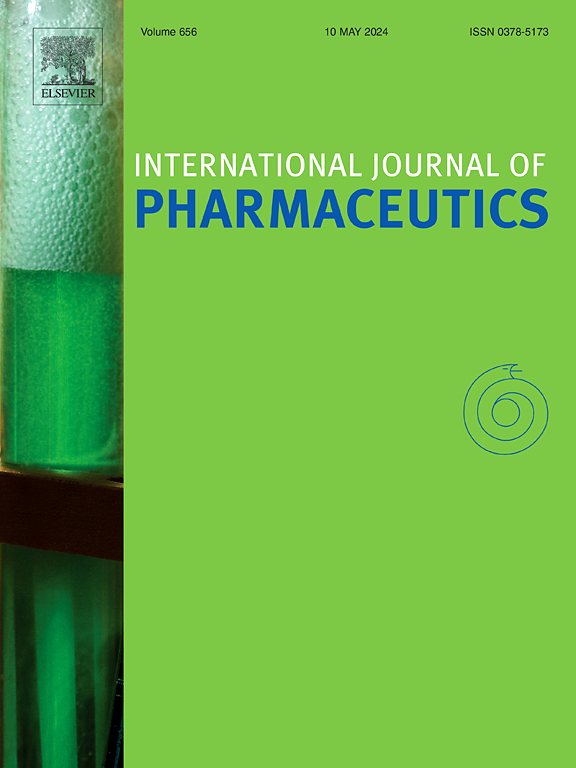A potential cocrystal strategy to tailor in-vitro dissolution and improve Caco-2 permeability and oral bioavailability of berberine
IF 5.3
2区 医学
Q1 PHARMACOLOGY & PHARMACY
引用次数: 0
Abstract
Berberine hydrochloride (BER), a promising candidate in treating tumors, diabetes and pain management, has relatively low oral absorption and bioavailability due to its low intestinal permeability. To address these challenges, we developed a BER and lornoxicam cocrystal (BLCC) by a solvent evaporation method and characterized it using X-ray diffraction, differential scanning calorimetry and thermogravimetric analysis. Compared with BER, BLCC exhibited an instant release in pH 1.0 HCl and a sustained release up to 24 h in pH 6.8 buffer solutions and water. The Caco-2 permeability of BLCC has shown a remarkable increase compared to that of BER (i.e., Papp(a→b): 50.30 × 10-7 vs 8.82 × 10-7 cm/s), which is attributed to the improved lipophilicity of BER (i.e., log P: 1.29 vs −1.83) and the reduced efflux amount of BER (i.e., ER: 1.71 vs 12.11). Furthermore, BLCC demonstrated a relative bioavailability of 410 % in comparison to the original BER, due to notably enhanced intestinal permeability of BLCC and its continuous dissolution in simulated intestinal fluid. BLCC has the potential to tailor the dissolution behavior, improve intestinal permeability, and boost the bioavailability of BER. This indicates that the cocrystal strategy holds promise as an effective approach to improving the oral absorption and bioavailability of active pharmaceutical molecules with low permeability during drug development.
定制体外溶解度、改善小檗碱的 Caco-2 渗透性和口服生物利用度的潜在共晶体策略。
盐酸小檗碱(BER)是治疗肿瘤、糖尿病和疼痛的有望候选药物,但由于其肠道渗透性低,口服吸收率和生物利用度相对较低。为了应对这些挑战,我们采用溶剂蒸发法研制出了盐酸拜耳和洛诺昔康共晶体(BLCC),并利用 X 射线衍射、差示扫描量热法和热重分析对其进行了表征。与 BER 相比,BLCC 在 pH 值为 1.0 的盐酸溶液中可瞬间释放,在 pH 值为 6.8 的缓冲溶液和水中可持续释放达 24 小时。与 BER 相比,BLCC 的 Caco-2 渗透性显著增加(即 Papp(a→b):50.30×10-7vs8.82×10-7cm/s),这归因于 BER 的亲脂性提高(即 log P:1.29 vs -1.83)和 BER 的外流量减少(即 ER:1.71 vs 12.11)。此外,由于 BLCC 的肠道渗透性明显增强,且能在模拟肠液中持续溶解,与原始 BER 相比,BLCC 的相对生物利用率提高了 410%。BLCC 具有定制溶解行为、改善肠道渗透性和提高 BER 生物利用率的潜力。这表明,在药物开发过程中,共晶策略有望成为改善低渗透性活性药物分子口服吸收和生物利用度的有效方法。
本文章由计算机程序翻译,如有差异,请以英文原文为准。
求助全文
约1分钟内获得全文
求助全文
来源期刊
CiteScore
10.70
自引率
8.60%
发文量
951
审稿时长
72 days
期刊介绍:
The International Journal of Pharmaceutics is the third most cited journal in the "Pharmacy & Pharmacology" category out of 366 journals, being the true home for pharmaceutical scientists concerned with the physical, chemical and biological properties of devices and delivery systems for drugs, vaccines and biologicals, including their design, manufacture and evaluation. This includes evaluation of the properties of drugs, excipients such as surfactants and polymers and novel materials. The journal has special sections on pharmaceutical nanotechnology and personalized medicines, and publishes research papers, reviews, commentaries and letters to the editor as well as special issues.

 求助内容:
求助内容: 应助结果提醒方式:
应助结果提醒方式:


